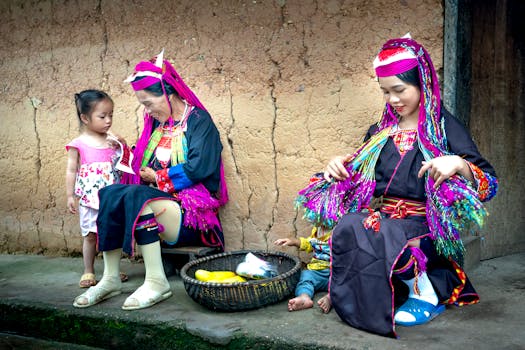
Connecting Cultures: The Story Behind Africa’s Diverse Fiber Traditions – WordPress
Africa is a continent steeped in tradition and cultural heritage, and one of the most significant expressions of this heritage is through its diverse fiber traditions. From the vibrant textiles of West Africa to the intricate beadwork of Southern Africa, each region has its unique story to tell through the art of fiber and textile production. In this article, we will delve into the world of African fiber traditions, exploring the history, cultural significance, and craftsmanship that goes into creating these stunning works of art.
The history of African fiber traditions dates back thousands of years, with evidence of textile production found in ancient civilizations such as Egypt, Nubia, and Axum. These early civilizations developed sophisticated techniques for spinning, weaving, and dyeing fibers, which were often used to create intricate garments and textiles for both practical and ceremonial purposes. As African cultures developed and migrated, so too did their fiber traditions, with different regions adapting and evolving their techniques to suit their unique environments and cultural needs.
One of the most distinctive aspects of African fiber traditions is the use of vibrant colors and bold patterns. In West Africa, for example, the iconic adinkra cloth of Ghana and the stunning indigo-dyed fabrics of Mali are renowned for their beauty and cultural significance. In East Africa, the Maasai people of Tanzania and Kenya are known for their brightly colored beadwork and woven baskets, which are not only functional but also carry deep cultural meaning. Similarly, in Southern Africa, the Zulu people of South Africa are celebrated for their intricate basket weaving and colorful textiles, which are often used in traditional ceremonies and rituals.
Despite the many variations and differences between African fiber traditions, there are some common themes that run throughout. One of the most significant is the importance of community and cooperation. In many African cultures, textile production is a communal activity, with women (and sometimes men) gathering to spin, weave, and dye fibers together. This communal approach not only fosters social bonding and cooperation but also ensures that traditional techniques and knowledge are passed down from generation to generation.
Another significant theme in African fiber traditions is the use of symbolism and metaphor. Many African textiles and garments are adorned with symbolic patterns and motifs that convey important messages about identity, status, and cultural values. For example, in some West African cultures, the color blue is associated with fertility and prosperity, while in other cultures, it may symbolize mourning or spirituality. Similarly, the patterns and motifs used in African textiles often have deeper meanings, such as the representation of ancestral spirits or the depiction of mythological creatures.
In addition to their cultural significance, African fiber traditions also play an important role in the continent’s economic development. Many African countries are now recognizing the value of their traditional textile industries, which not only provide employment and income for local communities but also contribute to the preservation of cultural heritage. In recent years, there has been a growing trend towards sustainable and ethical fashion, with many African designers and artisans incorporating traditional techniques and materials into their designs.
WordPress, as a platform, has also played a significant role in promoting African fiber traditions. Many African designers, artisans, and cultural institutions are now using WordPress to showcase their work, share their stories, and connect with a global audience. Through WordPress, it is possible to create stunning websites and online platforms that celebrate African fiber traditions, providing a unique opportunity for cultural exchange and education.
In conclusion, the story behind Africa’s diverse fiber traditions is one of cultural richness, community, and craftsmanship. From the vibrant textiles of West Africa to the intricate beadwork of Southern Africa, each region has its unique story to tell through the art of fiber and textile production. As we continue to celebrate and promote African fiber traditions, we must also recognize the importance of preserving cultural heritage and supporting sustainable and ethical fashion practices. By doing so, we can help to ensure that these stunning works of art continue to thrive and inspire future generations.
The significance of African fiber traditions extends beyond their aesthetic appeal, as they also carry deep cultural and historical meaning. The preservation of these traditions is crucial, as they provide a window into the past and a connection to the present. As we move forward in an increasingly globalized world, it is essential that we prioritize the preservation of cultural heritage and support the continuation of traditional practices.
Furthermore, African fiber traditions have the potential to play a significant role in the continent’s economic development. By promoting and supporting local textile industries, we can help to create employment opportunities and stimulate economic growth. Additionally, the incorporation of traditional techniques and materials into modern designs can help to create a unique and distinctive African aesthetic, which can be showcased on the global stage.
In order to fully appreciate the beauty and significance of African fiber traditions, it is essential to understand the historical and cultural context in which they developed. By exploring the history of textile production in Africa, we can gain a deeper understanding of the cultural and social factors that have shaped these traditions over time. This, in turn, can help us to appreciate the significance of African fiber traditions and the importance of preserving them for future generations.
Moreover, the study of African fiber traditions can also provide valuable insights into the cultural and social dynamics of African societies. By examining the role of textiles in African cultures, we can gain a better understanding of the ways in which culture and identity are constructed and negotiated. This, in turn, can help us to appreciate the complexity and diversity of African cultures and the importance of preserving cultural heritage.
In recent years, there has been a growing interest in African fiber traditions, with many designers and artists incorporating traditional techniques and materials into their work. This trend has been driven, in part, by a growing awareness of the importance of cultural heritage and the need to preserve traditional practices. Additionally, the incorporation of African fiber traditions into modern designs has helped to create a unique and distinctive aesthetic, which is being celebrated on the global stage.
However, despite the growing interest in African fiber traditions, there are still many challenges that need to be addressed. One of the main challenges is the lack of documentation and preservation of traditional techniques and knowledge. Many African cultures have an oral tradition, and the knowledge of traditional textile production is often passed down through generations by word of mouth. As a result, there is a risk that this knowledge will be lost over time, unless efforts are made to document and preserve it.
Another challenge facing African fiber traditions is the impact of globalization and urbanization. Many young people in Africa are moving to cities and adopting Western-style clothing, which can lead to a decline in the demand for traditional textiles. Additionally, the influx of cheap, imported clothing can make it difficult for local textile producers to compete, which can lead to a decline in the production of traditional textiles.
Despite these challenges, there are still many reasons to be optimistic about the future of African fiber traditions. Many African cultures are now recognizing the value of their traditional textile industries, and there is a growing trend towards sustainable and ethical fashion. Additionally, the incorporation of traditional techniques and materials into modern designs is helping to create a unique and distinctive African aesthetic, which is being celebrated on the global stage.
In conclusion, the story behind Africa’s diverse fiber traditions is one of cultural richness, community, and craftsmanship. From the vibrant textiles of West Africa to the intricate beadwork of Southern Africa, each region has its unique story to tell through the art of fiber and textile production. As we continue to celebrate and promote African fiber traditions, we must also recognize the importance of preserving cultural heritage and supporting sustainable and ethical fashion practices. By doing so, we can help to ensure that these stunning works of art continue to thrive and inspire future generations.


